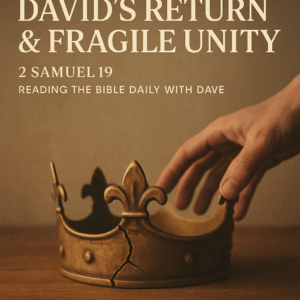⏱️ Estimated Reading Time: 4 min read
 “Context is king,” as it is often said. Context becomes even more important when it comes to reading the Scriptures. Some of the main hindrances Bible readers face when studying God’s Word is that they cannot get a grip for why the author said what he did, or why the audience responds the way they do. We get lost in confusing details and wordings and assume it’s simply beyond our ability to understand. When we take time to determine context, however, we find it much easier to break down confusion and start interpreting passages better.
“Context is king,” as it is often said. Context becomes even more important when it comes to reading the Scriptures. Some of the main hindrances Bible readers face when studying God’s Word is that they cannot get a grip for why the author said what he did, or why the audience responds the way they do. We get lost in confusing details and wordings and assume it’s simply beyond our ability to understand. When we take time to determine context, however, we find it much easier to break down confusion and start interpreting passages better.
But isn’t this hard to do solely from the Scriptures? Sometimes books of the Bible don’t give any sort of contextual clues to help us understand what’s going on in the first century. We do have a resource, however, in the writings of Second Temple Judaism that helps us bridge some of these contextual details that help our understanding of Scripture. Zondervan Academic’s Reading Romans in Context is one such resource that seeks to serve as that bridge, helping us understand Paul’s epistle to the Romans by adding a companion piece of non-Scriptural literature. Though what is not Scripture is not inerrant, this resource is a helpful guide, especially when placed alongside the text, to draw conclusions, and make connections.
The structure and outline of Reading Romans in Context is very simple to follow. Each chapter looks at a portion of Romans and at the same time analyzes those themes expressed elsewhere in the Apocrypha or other ancient texts, such as Wisdom of Solomon or Jubilees, as well as writings by men like Josephus and Philo. Each chapter starts with a helpful introduction, presents the non-Scriptural ancient text, and then a portion of Romans. At the end of the chapters are further reading recommendations, which are immensely helpful for the ambitious. Editors Ben Blackwell, John Goodrich, and Jason Maston have done a good job of keeping the book cohesive in nature and making it highly readable for such a deep, scholarly treatment of biblical study. There are a whole host of key contributors, such as Wesley Hill, Joseph Dodson, and Jonathan Linebaugh. This was a project carried out by a lot of people, with a lot of moving parts, but Reading Romans in Context manages to stay focused and help us come to this powerful portion of Scripture with clarity.
One of the great features of the book is that it’s only 192 pages total. Anyone going through a personal or small-group study of Romans could easily refer to this for some insight, yet it’s also dense enough for the pastor trying to gain better context for sermon prep. It is not a daunting textbook, but short and straightforward. Some of the most intriguing topics covered are “The Relationship between Justification and Suffering” (Chapter 7), “Israel’s Salvation and the Fulfillment of God’s Word” (Chapter 11), and “The Son of God and the Identity of Jesus” (Chapter 1).
As Romans is perhaps my favorite book of the Bible, I am really thankful for Reading Romans in Context as it really helps me know not only how to read and interpret these passages, but also how to preach and communicate them. It is important we determine the context when coming to the Word of God, that we may handle it rightly. This is a great resource to use if you desire to know Romans better, know the ancient texts better, and mostly to see their correlation. I hope to see more of these volumes covering other books in Scripture in the future.
I received this book for free from Zondervan Academic for this review. I was not required to write a positive review. The opinions I have expressed are my own. I am disclosing this in accordance with the Federal Trade Commission’s 16 CFR, Part 255: “Guides Concerning the Use of Endorsements and Testimonials in Advertising.”



